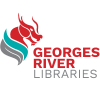
Harry Theak, Sydney Cricket Ground, 28 November 1932.
A cassette in our collection contains brief remarks from Don Bradman, in which he selected his best St George Cricket Club XI from all the cricketers he had seen playing for the club. He said: “Alan Fairfax and I became the club’s first international representatives in 1928. In the ensuing years many fine players gravitated through the St. George ranks; and I have taken the liberty of choosing a St George team which I would be happy to captain and challenge the best that could be chosen from any other club in Australia.
Here is my side in batting order: Arthur Morris, Les Favell, myself at first wicket, Norman O’Neill, Brian Booth, all-rounder Alan Fairfax, to keep wicket Ernie Laidler, to open the bowling Ray Lindwall and Harry Theak, and then the spinners Frank Ward and Bill O’Reilly, the greatest of them all. I am aware that Ernie Laidler and Harry Theak did not represent their country, but both were good enough to have done so. That is a beautifully balanced and attractive side.
Not only does this team have quality, it has character. When considering the stature of an athlete, I set great store on certain qualities which I believe to be essential in addition to skill. They are that the person conducts his life with dignity, with integrity, with courage and perhaps most of all with modesty. The players I have mentioned would stand up really well to those standards, as indeed would so many other players who brought lustre to the club, men like Bob Louden whose efforts never brought the rewards they deserved, Billy Watson, Ray Little, Warren Saunders, Albert Scanes and many others.”
Many of these cricketers are still familiar names today, but Harry Theak, whom Bradman rated as good enough to play for his country, perhaps needs some introduction.
Henry John Thomas (Harry) Theak played cricket for St George in the 1930s as a fast bowler. He played Sheffield Shield cricket for NSW, appearing alongside his fellow St George player Don Bradman on numerous occasions.
He was born at Pyrmont on 19 March 1909, son of Henry and Mabel (nee Keys) Theak. On leaving school, he found a job as an insurance clerk. By the 1930s, the family was living at Regent Street, Kogarah.
Theak, a tall red-head, played in various St George Association sides in the 1920s, representing the Association from 1925 onwards in inter-Association matches. He debuted for the St George District first-grade team in 1929 and was soon a regular in the side. An advert for Allen Brothers, the local menswear shop, broke into verse: “If you wish to be a Bradman/ or a Fairfax or a Theak/ You must give your full attention/ to practice every week.”
His performances for St George earned him a place in the NSW team on 23 occasions, from 1929-1935. He came close to selection for Australia in 1932. However, he played for NSW against England in a tour match at the Sydney Cricket Ground in November 1932, (when these two photographs were taken). On this occasion England disposed of NSW by an innings and 44 runs. Bradman failed to fire, and Theak had no success bowling against England’s stodgy defence and was unable to push for Test selection. That particular England team, of course, achieved notoriety as the proponents of ‘bodyline’ tactics.
Harry married Edna Griffin on 6 March 1937 at Christ Church, Bexley. They lived at 76 Woniora Road, and later in Joffre Street, Hurstville. During WWII he served in the Citizens’ Military Forces as N241075.
He died at Narwee on 14 September 1979, aged 70.

Harry Theak in the nets, Sydney, 28 November 1932. Possibly Jack Fingleton at right?
